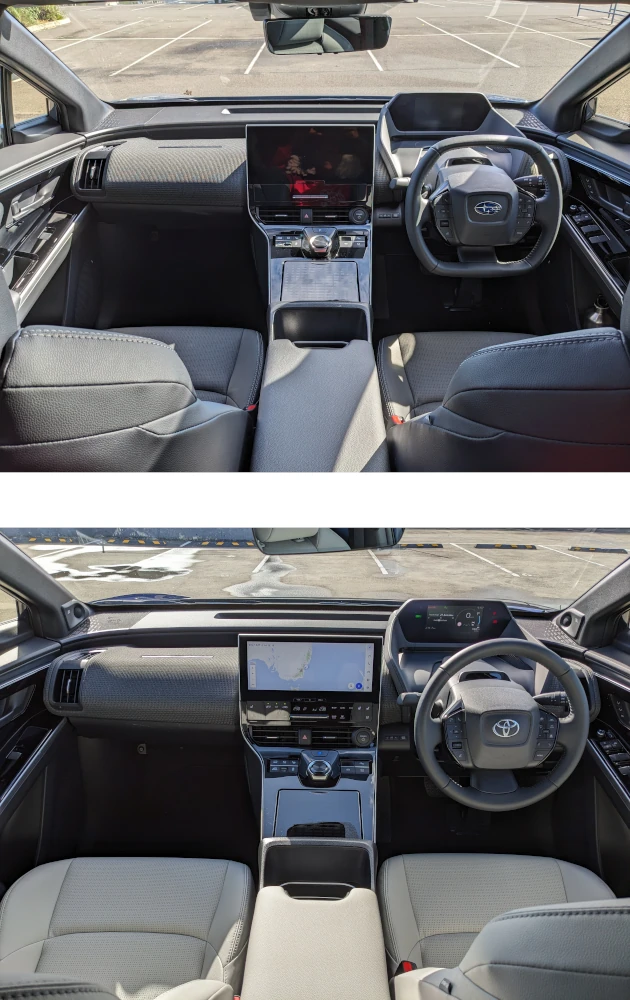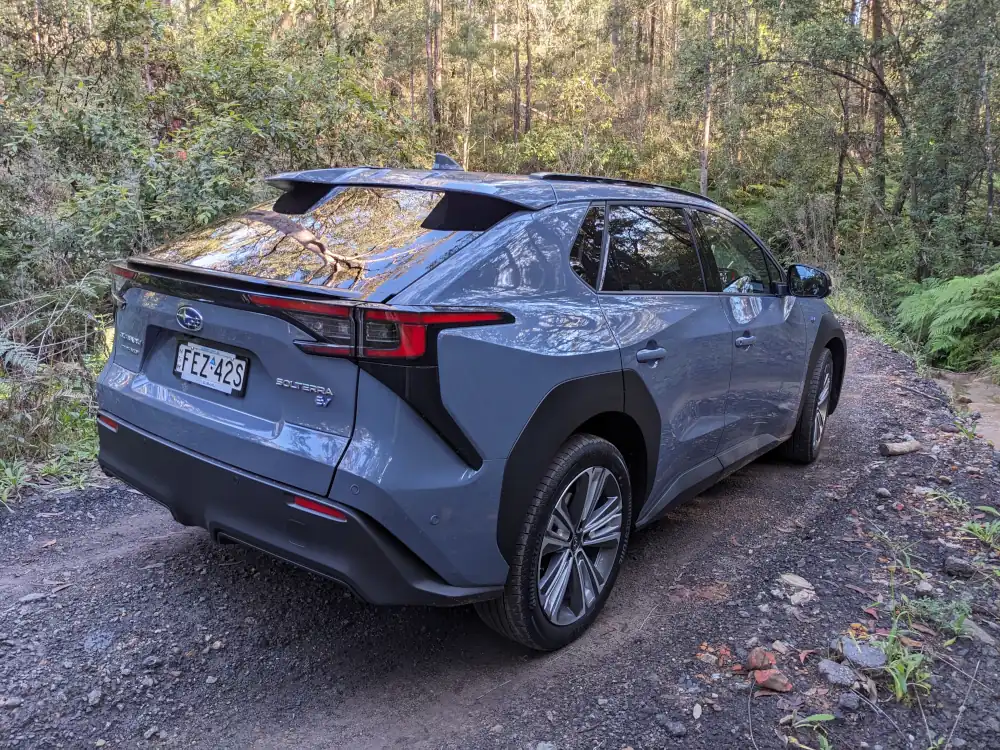After returning a Toyota bZ4X a month ago, I hopped straight into a Subaru Solterra AWD Touring for a week. I knew the two vehicles were jointly developed by Toyota and Subaru and built in the same factory, but was still surprised by how they are nearly identical inside and out.

Manufacturer logos and name badges are the only way you can really tell these two vehicles apart on the outside.
From the driver’s seat you could easily mistake one for the other, especially if you cover up the logo in the centre of the steering wheel. The Solterra steering wheel is squared off compared to the traditional round wheel of the bZ4X though.

Despite being identical twins, there are obviously more loyal Toyota customers out there, with the bZ4X selling nearly double (458) compared to the Subaru Solterra (247) since both launched earlier this year.
The Subaru Solterra is priced from $75,749 driveaway in NSW for the base AWD variant and $83,099 for the Touring tested here, which is still a huge premium over Subaru’s popular ICE models as a base Forester costs $43,585 driveaway and an Outback starts from $48,759 in NSW.
Before I bought my Tesla Model 3, I owned a 2004 Subaru Outback for 13 years. It was a great car and took us on many adventures including a big lap around Australia in 2007. When I sold it in 2019 it had clocked up over 200,000 km and was still running well apart from needing the oil topped up every now and then.

Prior to the Outback I also owned an Impreza, so I guess you could call me a one time loyal Subaru fan, having owned Subaru cars for nearly 20 years. I was therefore keen to try out Subaru’s first EV to see how it stacks up against my old Outback and whether other Subaru fans would be happy with one.
Subaru Solterra vs Toyota bZ4X
If you dive into the details there are a few minor differences between the Subaru and Toyota EVs. Toyota offers the bZ4X with a choice of front-wheel drive or all-wheel drive, while the Solterra comes in all-wheel drive only. Apart from that, the drivetrain and battery specifications are exactly the same.
Subaru must think their customers will use the Solterra in cold environments as the Touring variant comes with heated rear seats as well as heated front seats which the Toyota has. The Solterra misses out on ventilated front seats found in the Toyota, which is unfortunate for people who get sweaty while driving or live in hot climates.
The Solterra has more choice when it comes to regenerative braking, with five different levels available via steering wheel paddles. You can also go straight to the strongest setting via the same button found on the bZ4X centre console, although just like the Toyota it won’t bring you to a full stop.
Servicing and warranty periods for the Solterra match the bZ4X, with 12 months or 15,000 km intervals. However, Subaru includes a 5 year / 75,000 km service plan and roadside assistance package with the Solterra, saving $900 compared to Toyota’s 5 year capped price service plan.
Minor differences aside, the overall driving experience between these two EVs is nearly identical, at least in the all-wheel drive bZ4X I tested beforehand. For more details, see my previous article on the Toyota bZ4X. The most significant difference I found during my week of driving came down to efficiency.
Solterra more efficient than the bZ4X
Even though I drove the Subaru and Toyota on similar roads a week apart, I found the Solterra was noticeably more efficient both around town and on the highway. On the highway I averaged 17.4 kWh/100 km in the Solterra while the bZ4X returned 19.6 kWh/100 km.
Around the suburbs the Solterra fared better still, averaging 16.3 kWh/100 km vs 19.2 kWh/100 km for equivalent driving in the bZ4X.

I can’t find any good explanations for this discrepancy between these two almost identical cars either. The WLTP range for both AWD variants I tested is within 3 km of each other and both are fitted with efficient heat pump air conditioning systems, so they should give similar results.
You could chalk it up to differences between the individual vehicles I tested, but 10-15 % difference in efficiency seems like too much to attribute to this alone. Tyre pressure was set correctly in both cars as per manufacturer recommendations too, so who knows.
Would I take a Solterra EV off the beaten track?
One day I would like to drive around Australia again, but in an EV next time and with less time constraints to do more side trips. The number of people completing the big lap in their EVs these days certainly proves it is getting easier, and some are even upping the ante by towing a trailer and boat or modified caravans.
Last time around, the Subaru Outback proved capable of handling everything we threw at it including a creek crossing that washed up over the bonnet on the road out to El Questro Gorge. In hindsight I should have tested the depth myself instead of believing the ranger who told us it would be shallow enough.
Apart from a squelchy sound while turning the steering wheel for a short while after, the Outback was fine in the end. I would be more worried about water damage doing something like this in an EV, as well as electrical or mechanical repairs being harder in general, especially in remote outback areas.

I took the Solterra on some dirt roads and it seemed to handle those well, so I have no doubt it would be capable of going everywhere my old Outback went. While I found the Solterra more efficient than the bZ4X, unfortunately it is still hamstrung by a shorter range than other electric SUVs plus an inferior charging experience.
With these concerns in mind, if I was heading off the beaten track tomorrow I would opt for a combustion powered Subaru over a Solterra EV just for peace of mind. As remote charging infrastructure and technology improves rapidly, along with brands like Rivian eventually arriving in Australia, I’m hoping we see more EVs on the road exploring our beautiful country.
Table of key specifications
| Variant | Subaru Solterra AWD Touring | ||
| Starting price | $76,690, plus on-road costs | ||
| Paint colours and options | 6 colours at no cost:
Two-tone colours, $1,200 option:
|
||
| Battery size | 71.4 kWh gross, 64 kWh usable | ||
| Battery chemistry and manufacturer | Nickel Manganese Cobalt (NMC), CATL | ||
| Range | 414 km WLTP | ||
| Driven wheels | All-wheel drive | ||
| Power / Torque | 160 kW / 337 Nm | ||
| Charging socket | CCS2 combo | ||
| Maximum charging speed | 11 kW AC, 150 kW DC | ||
| Charging time | 7 kW AC (0 – 100 %) – 9.5 hours 11 kW AC (0 – 100 %) – 6.5 hours 150 kW DC (0 – 80 %) – 30 minutes |
||
| Exterior dimensions | Length: 4690 mm Width: 1860 mm Height: 1650 mm Wheelbase: 2850 mm Ground clearance: 212 mm |
||
| Kerb weight | 2060 kg | ||
| Storage space | Frunk: N/A Boot, rear seats up: 410 L |
||
| Service interval | 12 months / 15,000 km | ||

Tim has 20 years experience in the IT industry including 14 years as a network engineer and site reliability engineer at Google Australia. He is an EV and renewable energy enthusiast who is most passionate about helping people understand and adopt these technologies.

